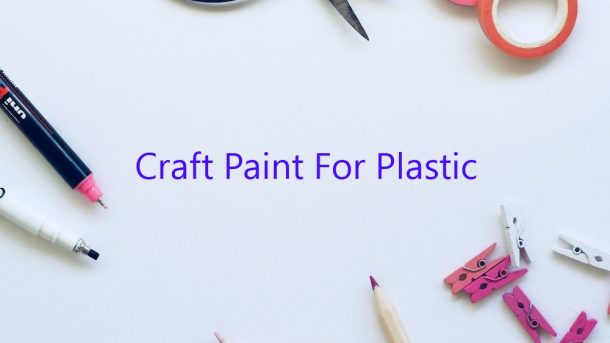Craft paint is a versatile medium that can be used to create a wide variety of projects. In addition to painting on canvas, craft paint can also be used to embellish a variety of other surfaces, including plastic.
When using paint to decorate plastic, it is important to use a type of paint that is specifically designed for plastic. This is because regular craft paint can be dissolved by the solvents that are commonly used to make plastics flexible.
There are a number of different brands of craft paint that are designed for use on plastic, and each offers its own set of benefits. One of the most popular brands is Plaid, which offers a wide range of colors and finishes that can be used to create a variety of different effects.
Another popular brand of craft paint for plastic is FolkArt, which is known for its high quality and long-lasting results. FolkArt offers a variety of finishes, including metallic and pearlized shades, that can add a touch of luxury to any plastic project.
When using craft paint to decorate plastic, it is important to take into account the type of plastic that is being used. Some types of plastic are more flexible than others, and this can affect the way the paint looks once it is dry.
In general, the more flexible the plastic is, the more likely it is that the paint will stretch and smear when it is flexed. This can be a desirable effect for some projects, but it is important to be aware of it before starting to paint.
It is also important to make sure that the paint is completely dry before trying to flex the plastic. If the paint is not completely dry, it can smudge and smear, which can ruin the finished project.
When using craft paint to decorate plastic, it is important to take into account the type of paint that is being used. Some paints are designed to be used on a variety of different surfaces, while others are designed for use on specific types of surfaces.
In general, it is best to use a paint that is specifically designed for the type of surface that is being decorated. This is because paints that are designed for general use often contain solvents that can dissolve the surface of plastic.
If a paint that is designed for general use is used to decorate plastic, it is likely that the paint will start to peel and chip away within a few days. This can be extremely frustrating, especially if the project is not finished yet.
In order to avoid this problem, it is important to use a paint that is specifically designed for use on plastic. These paints are typically less likely to damage the surface of the plastic, and they often provide a higher quality of finish.
When using craft paint to decorate plastic, it is important to take into account the type of paint that is being used. Some paints are designed to be used on a variety of different surfaces, while others are designed for use on specific types of surfaces.
In general, it is best to use a paint that is specifically designed for the type of surface that is being decorated. This is because paints that are designed for general use often contain solvents that can dissolve the surface of plastic.
If a paint that is designed for general use is used to decorate plastic, it is likely that the paint will start to peel and chip away within a few days. This can be extremely frustrating, especially if the project is not finished yet.
In order to avoid this problem, it is important to use a paint that is specifically designed for use on plastic. These paints are typically less likely to damage the surface of the plastic,
Contents
What type of craft paint can be used on plastic?
There are a few different types of paint that can be used on plastic. Acrylic paint is a good option because it is water-based and doesn’t contain any harsh chemicals. Another option is spray paint, which is available in a variety of colors. However, it is important to note that spray paint can be harmful to breathe in, so it is best to use it in a well-ventilated area. Enamel paint is also a good option for painting plastic, but it is important to make sure that the paint is specifically designed for use on plastic, as other types of paint can damage the surface.
Can you paint plastic with craft paint?
Can you paint plastic with craft paint?
Yes, you can! However, the results may not be what you expect.
Craft paint is designed to be used on surfaces like wood, metal, and ceramics. It is not usually recommended for use on plastic.
That said, some people have had success in using craft paint to paint plastic surfaces. The key is to make sure that the paint is properly diluted and to use a gentle brush-stroke.
It is also important to note that not all plastics are created equal. Some plastics are more porous than others, which means that they will absorb the paint more easily.
If you are looking to paint a plastic surface, it is best to test out a small area first to see if the paint will adhere properly.
What paint is best to use on plastic?
What paint is best to use on plastic?
There are a few things to consider when painting plastic. The first is the type of plastic. There are different types of plastic, and each will react differently to paint. The second is the paint itself. Not all paints are created equal, and some work better on plastic than others.
When painting plastic, it is important to use the right type of paint. Acrylic paint is a good option for painting plastic. It is water-based and easy to use. It also dries quickly, which is important when painting plastic, as you don’t want the paint to sit on the plastic for too long. Another option is enamel paint. Enamel paint is oil-based, so it is more durable than acrylic paint. It is also less likely to chip or peel off the plastic. However, enamel paint is more difficult to work with than acrylic paint, and it takes longer to dry.
It is also important to use the right type of paintbrush when painting plastic. A good option is a synthetic-bristle paintbrush. These brushes are designed to work with acrylic paint, and they are less likely to leave streaks or brush marks on the plastic.
Do you need to prime plastic before painting?
In order to achieve the best possible finish when painting plastic, is it necessary to prime the surface first?
The answer to this question is not always straightforward, as it depends on the type of plastic and the paint that is being used. In some cases, priming is definitely necessary, while in others it may not be necessary at all.
One thing to keep in mind is that not all plastics are created equal. Some are harder and more resistant to paint than others. If you are unsure about whether or not to prime a particular surface, it is best to test a small area first to see how the paint behaves.
If you are using a standard acrylic paint, then priming is likely to be necessary. This type of paint tends to be less durable than other types, and can easily chip or peel if it is not properly adhered to the surface.
If you are using an enamel paint, then priming is usually not necessary. Enamel paint is much more durable than acrylic paint, and is less likely to chip or peel.
There are also a number of specialized paints available that are designed for use on plastic surfaces. These paints are usually designed to be used without priming, and will adhere to the surface very well.
In general, if you are using a good quality paint and the plastic is not too resistant, then priming is not usually necessary. However, if you are unsure about the paint or the plastic, it is always best to test first.
How do you get paint to stick to plastic?
There are a few ways to get paint to stick to plastic.
One way is to use an adhesive primer. This will help the paint stick to the plastic and will make it less likely to chip or peel.
Another way is to use a spray paint designed for plastic. This will create a sealant on the plastic that will help the paint stick.
Finally, you can use a sealant or a top coat after the paint has dried. This will help protect the paint from chipping or peeling.
How do you make paint stay on plastic?
One of the great things about paint is that it can be used to create beautiful works of art, or to simply brighten up a room. However, one of the challenges with using paint is making sure it stays on the surface you are painting. In particular, paint can be difficult to keep on plastic surfaces.
There are a few things you can do to make sure your paint stays on plastic. The first is to make sure you are using the right type of paint for the surface you are painting. Acrylic paint is a good option for painting on plastic, as it is designed to stick to surfaces.
Another thing you can do is to prepare the surface properly before painting it. Clean the surface of any dirt or grease with a mild detergent, then dry it thoroughly. This will help the paint stick better.
Finally, you can use a sealant to help the paint stick better and to protect it from fading or peeling. Apply a coat of sealant to the surface after you have finished painting it.
With these tips, you should be able to make your paint stay on plastic surfaces for a long time.
How do you keep acrylic paint from chipping on plastic?
Paint is a versatile medium that can be used to create a variety of different artworks. However, when it comes to using paint on plastic, there are a few things to keep in mind in order to prevent the paint from chipping.
One of the main reasons why paint chips on plastic is because the two materials have different levels of flexibility. When the paint is applied to the plastic, it can start to chip and crack as the plastic begins to move and flex. In order to prevent this from happening, it is important to use a sealant on the plastic before painting. This will help to create a barrier between the paint and the plastic, and will help to keep the paint from chipping.
Another thing to keep in mind when painting on plastic is the type of paint that is being used. Acrylic paint is a good option for painting on plastic, as it is a flexible paint that is less likely to chip than other types of paint. When using acrylic paint, it is important to make sure that the paint is fully dry before applying a sealant. If the paint is not fully dry, the sealant will not be able to properly seal the paint and will not prevent the paint from chipping.
Finally, it is important to be patient when painting on plastic. Take your time and make sure that each layer of paint is fully dry before adding another layer. This will help to prevent the paint from chipping and will create a more durable finished product.




